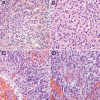Glioblastoma with oligodendroglioma component (GBM-O): molecular genetic and clinical characteristics
- PMID: 23289977
- PMCID: PMC4868066
- DOI: 10.1111/bpa.12018
Glioblastoma with oligodendroglioma component (GBM-O): molecular genetic and clinical characteristics
Abstract
Glioblastoma (GBM) is an aggressive primary brain tumor with an average survival of approximately 1 year. A recently recognized subtype, glioblastoma with oligodendroglioma component (GBM-O), was designated by the World Health Organization (WHO) in 2007. We investigated GBM-Os for their clinical and molecular characteristics as compared to other forms of GBM. Tissue samples were used to determine EGFR, PTEN, and 1p and 19q status by fluorescence in situ hybridization (FISH); p53 and mutant IDH1 protein expression by immunohistochemistry (IHC); and MGMT promoter status by methylation-specific polymerase chain reaction (PCR). GBM-Os accounted for 11.9% of all GBMs. GBM-Os arose in younger patients compared to other forms of GBMs (50.7 years vs. 58.7 years, respectively), were more frequently secondary neoplasms, had a higher frequency of IDH1 mutations and had a lower frequency of PTEN deletions. Survival was longer in patients with GBM-Os compared to those with other GBMs, with median survivals of 16.2 and 8.1 months, respectively. Most of the survival advantage for GBM-O appeared to be associated with a younger age at presentation. Among patients with GBM-O, younger age at presentation and 1p deletion were most significant in conferring prolonged survival. Thus, GBM-O represents a subset of GBMs with distinctive morphologic, clinical and molecular characteristics.
© 2013 The Authors; Brain Pathology © 2013 International Society of Neuropathology.
Figures



References
-
- Aldape K, Burger PC, Perry A (2007) Clinicopathologic aspects of 1p/19q loss and the diagnosis of oligodendroglioma. Arch Pathol Lab Med 131:242–251. - PubMed
-
- Brat DJ, Parisi JE, Kleinschmidt‐DeMasters BK, Yachnis AT, Montine TJ, Boyer PJ et al (2008) Surgical neuropathology update: a review of changes introduced by the World Health Organization (WHO) classification of tumors of the central nervous system, 4th edition. Arch Pathol Lab Med 132:993–1007. - PubMed
-
- Brat DJ, Prayson RA, Ryken TC, Olson JJ (2008) Diagnosis of malignant glioma: role of neuropathology. J Neurooncol 89:287–311. - PubMed
-
- CBTRUS (2012) CBTRUS Statistical Report: Primary Brain and Central Nervous System Tumors Diagnosed in the United States in 2004–2008 (March 23, 2012 Revision). Central Brain Tumor Registry of the United States, Hinsdale, IL.
-
- Coons SW, Johnson PC, Scheithauer BW, Yates AJ, Pearl DK (1997) Improving diagnostic accuracy and interobserver concordance in the classification and grading of primary gliomas. Cancer 79:1381–1393. - PubMed
Publication types
MeSH terms
Substances
Supplementary concepts
Grants and funding
LinkOut - more resources
Full Text Sources
Other Literature Sources
Medical
Research Materials
Miscellaneous

